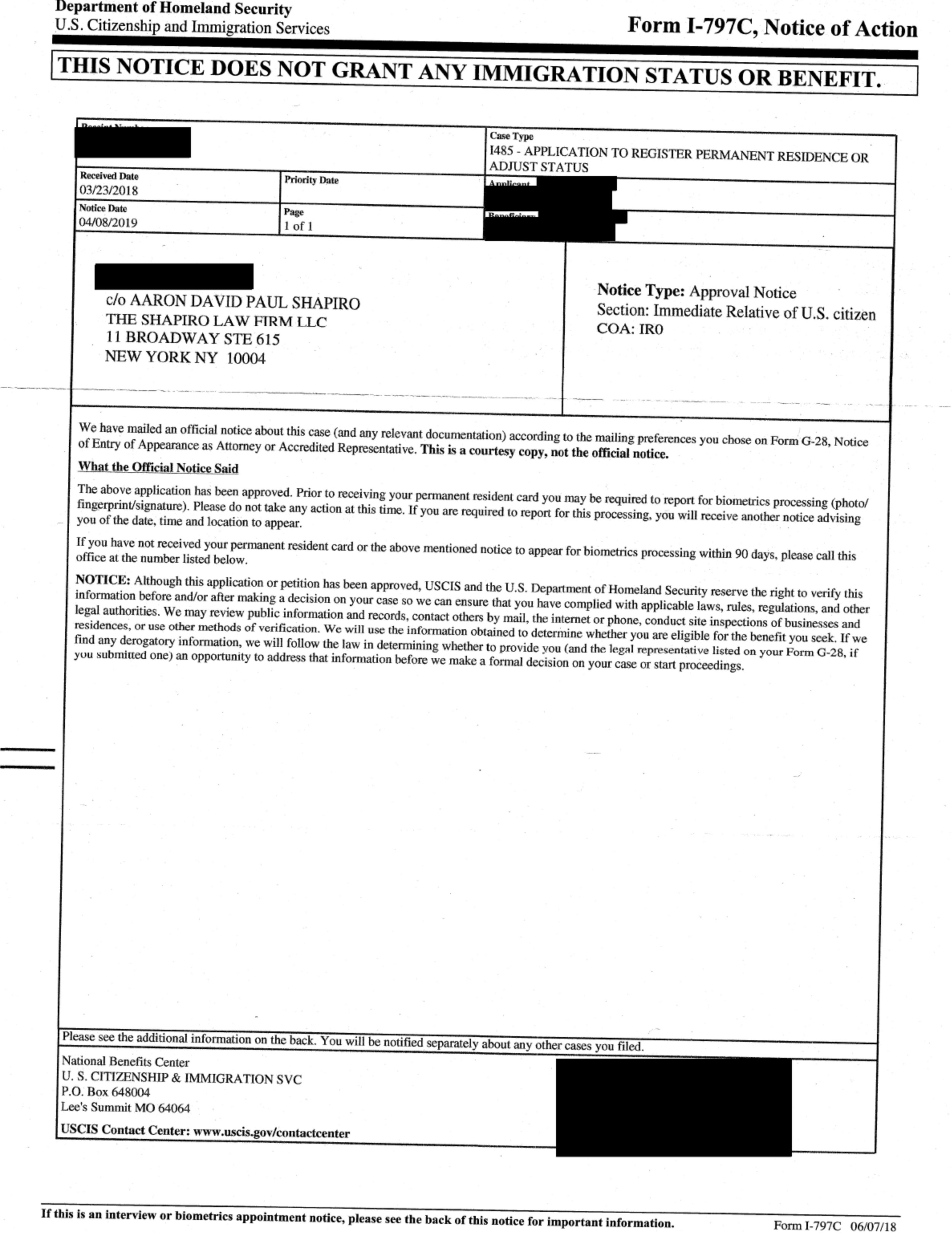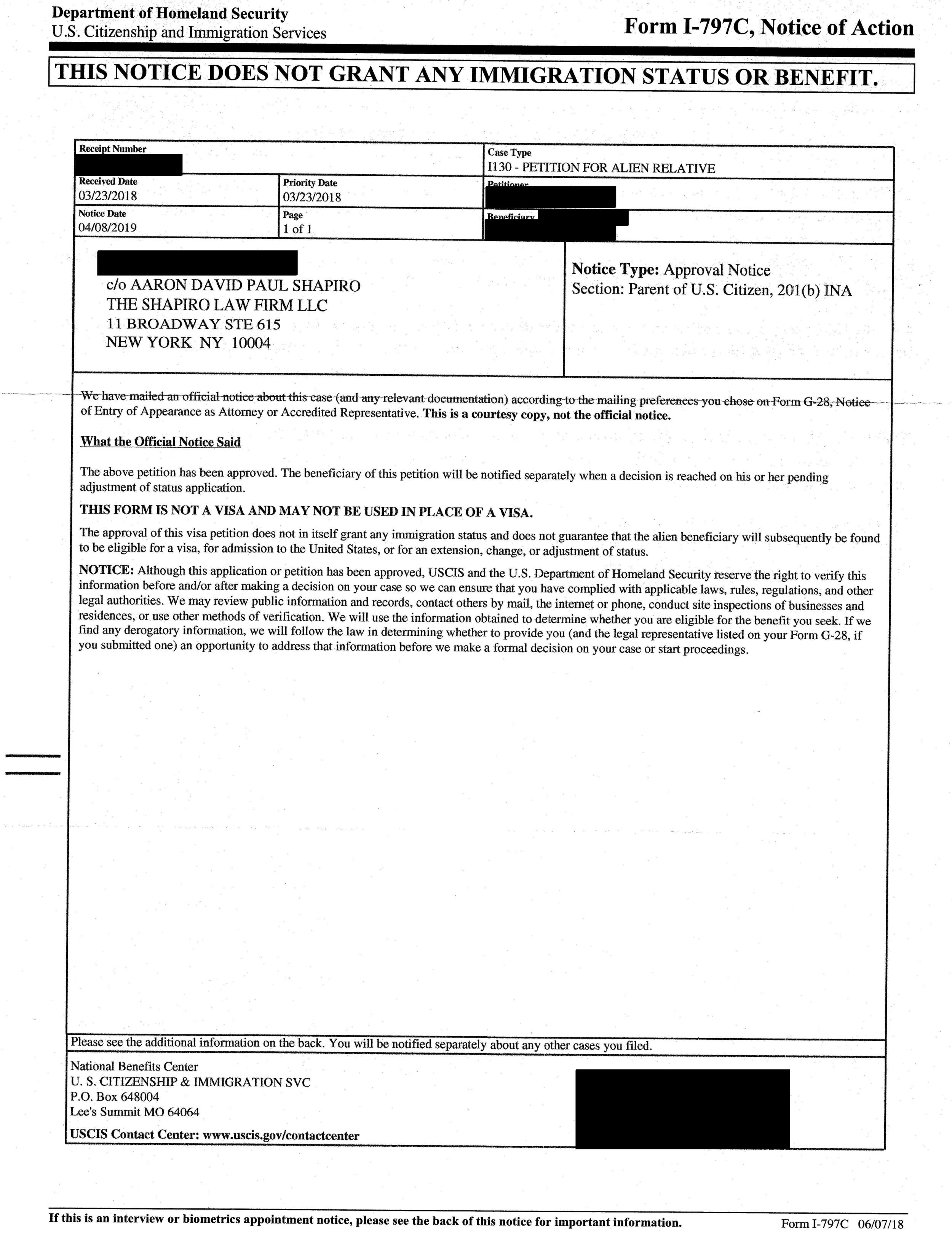Case Status Update | *Notable Approval | Green Card (finally) Approved for Parent of U.S. Citizen
Welcome to The Shapiro Law Firm, LLC’s Case Status Updates, *Notable Approvals. The hard-working immigration attorneys at The Shapiro Law Firm, LLC, enjoy posting Case Status Updates for every approval that we obtain for our wonderful clients! Some of our approvals deserve a more detailed account due to the complex legal and/ or factual issues involved. Accordingly, we are proud to present The ESinQuire™ Blog’s latest series, “Case Status Update | *Notable Approvals.”
*Notable Approval #1 - Parent of U.S. Citizen Finally Becomes a Lawful Permanent Resident (“LPR”)
Our first *Notable Approval is for a client, (hereinafter, client “M”), who is a native and citizen of Antigua. M entered the U.S. in 1980 using someone else’s French passport. M subsequently lost the documents that she used to enter the country when her apartment caught on fire.
In 1987, M filed to become a temporary resident under the old Legalization law.* M’s entry using another person’s passport rendered her inadmissible due to fraud/ misrepresentation, so in order to have her application for temporary residence approved, she had to file for a I-690 waiver of excludability. Both applications were granted and M became a temporary resident.
M renewed her temporary residency three times and was told by her prior attorney that her temporary residency provides a path to permanent residency (aka a Green Card). M’s attorney, however, did not inform her that she needed to file a separate application to became a permanent resident, so she never did and the statutory time period for her to do so came and went. M had no idea that by failing to file for permanent residency in the allotted time period, that she lost her temporary residency and thus she went back to being in unlawful immigration status.
For almost 3 decades M continued to work and live in the U.S. without issue. It was not until her long-time employer need to re-verify her work authorization when M first learned something was wrong.
After the problem at work, M came to our office with her U.S. Citizen Son (who was over the age of 21). M explained to us what happened and stood by her belief that she was a permanent resident. When we asked to see her Green Card, all she had was her old Temporary Resident Card. At that point, we explained to her that the change to permanent residence was not automatic, and since she never filed for it, it meant that she had been unlawfully present in the United States since her last temporary residence extension expired in 1990.
We then told her that we need to order M’s FOIA (Freedom of Information Act Request) file in order to see what exactly happened in the late 1980s and early 1990s. Although M’s U.S. Citizen could file an I-130 petition for her, we were concerned that M did not have a lawful entry, which is a requirement for adjustment of status purposes.
A few months later, M’s FOIA file arrived and we carefully reviewed it. We also extensively researched the now expired legalization law and determined that M’s approved I-690 waiver of excludability waived the indamssiblity ground relating to her fraudulent entry permanently for the purposes of future immigration benefits applications, including immigrant and nonimmigrant benefits. This meant that M’s waiver based on her fraudulent entry was still in effect, and thus she was elite to adjust her status based on the I-130 filed by her U.S. Citizen son.
Despite the good news, we cautioned M that it still may be easier said than done since the law that supported our analysis had been defunct for almost 30 years, and would thus be unfamiliar to current USCIS employees. We were confident that our analysis was right, but assumed that it would take longer than normal (which is long to begin with!) to get approved.
We then concurrently filed the I-130 Alien Relative Petition and I-485 Adjustment of Status Application on M’s behalf, as we would for any adjustment of status applicant who does not need any waivers. We also submitted an I-765 Employment Authorization Document (EAD) application with the package.
About 6 months later, before M’s EAD was approved, USCIS sent a request for evidence (RFE) for proof of M’s lawful entry. Despite submitting all of the proof of that we had (the evidence of the fire, the legalization application, the temporary resident card, the I-690 waiver of excludability application and the handwritten notes from INS approving the waiver) with the initial application package, we re-submitted it in response to the RFE with a cite to the appropriate law (INA Section 245A) with an affidavit from M and an explanation that M already obtained a waiver for her fraudulent entry that was still in effect. M’s EAD was subsequently approved, a promising sign.
M was then called in for an interview with USCIS, which I attended with her. As expected, the sole issue brought up by the officer at the interview was M’s entry and purported waiver. I brought copies of all of the relevant documents to the interview, as well as copies of the section of law that supported our analysis. After I explained it all to the officer, he said that it sounded good and that we were right but that he was not familiar with the law and would need to run it past his supervisor before it could be approved. This was the best news that we could have hoped for and I was excited for M, but she was understandably still worried to leave the office that day without an approval.
A few weeks alter, the approval finally came in the mail! M is ecstatic to finally become a lawful permanent resident after residing in the U.S. unlawfully for almost 30 years!
We felt that this case was a *Notable Approval due to the complex issue involving a law that expired almost 30 years ago. We knew that USCIS (which did not even exist when the law was in effect. Rather, this agency was known as the Immigration and Naturalization Services or INS) would be completely unfamiliar with the law and the effect of the waiver granted so long ago. In addition, the fact that M’s entry documents were lost in a fire and the fact that the only proof that she had that the waiver was approved was handwritten notes scribbled on the application by an INS employee, made the situation even trickier. These complex legal issues and facts were no match for the diligent immigration attorneys at The Shapiro Law Firm, LLC who properly analyzed the relevant laws and provided USCIS with a clear and concise explanation of why M was eligible to become a permanent resident.
If you have a complicated immigration history and would like the experienced immigration attorneys at The Shapiro Law Firm, LLC to review your case to see if you can obtain legal status, contact us today!
*Legalization under INA Section 245A allowed certain individuals who were unlawfully in the U.S. prior to January 1, 1982 and who were physically present in the U.S. from November 6, 1986 until the date of filing the application to become temporary residents. Upon application and fulfillment of continuous residence requirements, temporary residents could then apply to become permanent residents. There was only a small period to file these applications from May 5, 1987 to May 4, 1988 (with one exception for individuals classified under “extended voluntary departure,” who were given until December 22, 1989 to file).
(*please note that all identification information has been removed in order to protect our clients' privacy and in order to fully comply with attorney advertising rules and regulations*)
disclaimer | “Attorney Advertising” The information contained in this website is intended to convey general information. It should not be construed as legal advice or opinion. It is not an offer to represent you, nor is it intended to create an attorney-client relationship. Any email sent via the Internet using email addresses listed in this website would not be confidential and would not create an attorney-client relationship.







